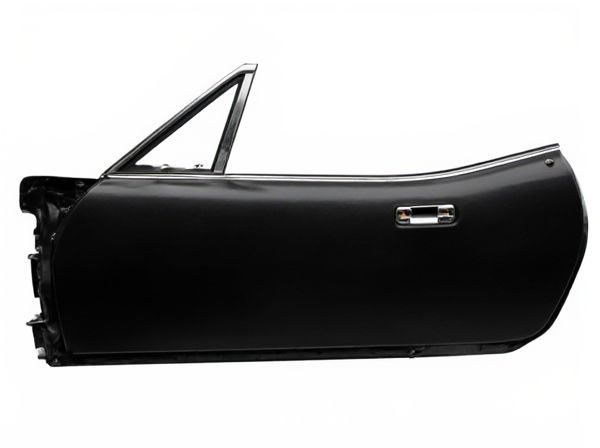
Photo illustration: Suicide Door vs Conventional Door
Suicide doors, hinged at the rear instead of the front, offer easier access to the vehicle's interior and create a unique aesthetic appeal compared to conventional doors. These doors provide better entry and exit in tight spaces but may pose safety concerns if not properly secured while driving. Understanding the difference helps you choose the style and functionality that best suits your vehicle preferences.
Table of Comparison
| Feature | Suicide Door | Conventional Door |
|---|---|---|
| Hinge Position | Rear-hinged | Front-hinged |
| Ease of Entry/Exit | Improved rear seat access | Standard access, less rear space |
| Safety | Higher risk if door opens while moving | Safer, doors resist wind force when moving |
| Typical Use | Luxury and classic cars | Most modern vehicles |
| Aesthetic Appeal | Unique, vintage style | Conventional and practical look |
| Installation Complexity | More complex, requires reinforced frame | Standard installation |
Introduction to Car Door Types
Suicide doors, also known as rear-hinged doors, open opposite to conventional front-hinged car doors, offering easier rear-seat access and a distinctive vintage aesthetic. Conventional doors are the most common design, hinged at the front, prioritizing safety by closing opposite the direction of travel to minimize accidental opening while driving. Understanding these differences helps in selecting a car based on functionality, safety, and style preferences.
What Are Suicide Doors?
Suicide doors are hinged at the rear rather than the front, allowing the door to open backward, which enhances passenger entry and exit by providing a wider opening. Popularized in classic cars and modern luxury vehicles, suicide doors improve accessibility and style but require additional safety features to prevent accidental opening while driving. In contrast to conventional doors, which open forward with front hinges, suicide doors offer a unique combination of functionality and aesthetic appeal.
Understanding Conventional Car Doors
Conventional car doors, typically hinged at the front, open outward in a forward direction, allowing easy entry and exit while enhancing safety by preventing accidental opening while driving. These doors are standard in most vehicles due to their structural integrity and compatibility with modern safety features like side-impact beams. Understanding the mechanics and safety benefits of conventional doors highlights why they remain the predominant choice over alternative designs like suicide doors.
Historical Evolution of Suicide Doors
Suicide doors, characterized by hinges mounted at the rear rather than the front, emerged prominently in early 20th-century automobiles, offering easier access to rear seats and a distinctive aesthetic. These doors were gradually phased out in favor of conventional doors due to safety concerns, as front-hinged models reduced the risk of doors swinging open while driving. The revival of suicide doors in luxury and concept vehicles highlights their enduring appeal as a design element, blending historical craftsmanship with modern safety innovations.
Safety Considerations: Suicide vs Conventional Doors
Suicide doors, hinged at the rear, present unique safety challenges due to their tendency to open unexpectedly while driving if not properly latched, increasing the risk of passenger ejection. Conventional doors, hinged at the front, offer enhanced security by naturally resisting opening during motion, minimizing accidental openings and improving crash safety. Modern automotive design standards favor conventional doors for their proven ability to protect occupants in collisions and reduce hazards associated with door operation.
Design and Aesthetic Differences
Suicide doors feature hinges mounted at the rear, creating a distinctive, retro-inspired design that enhances vehicle accessibility and visual appeal. Conventional doors use front-mounted hinges, resulting in a familiar, forward-opening style that emphasizes practicality and safety. The unique opening mechanism of suicide doors often lends vehicles a luxurious, dramatic aesthetic, contrasted with the functional, standardized look of conventional doors.
Practicality and Accessibility Comparison
Suicide doors provide enhanced accessibility by allowing a wider opening since they hinge at the rear, making entry and exit easier, especially in tight parking spaces or for passengers with limited mobility. Conventional doors, hinging at the front, offer more structural rigidity and are generally considered safer in forward collisions, but they restrict space when opening in confined areas. Practicality depends on context; suicide doors excel in ease of access and stylish appeal, while conventional doors prioritize security and familiar functionality.
Popular Car Models Featuring Suicide Doors
Popular car models featuring suicide doors include the Rolls-Royce Phantom, Lincoln Continental, and Tesla Model X, each showcasing distinct design advantages for passenger access and comfort. Suicide doors, hinged at the rear, provide easier entry and exit, especially in tight parking spaces, compared to conventional front-hinged doors found on most vehicles like the Toyota Camry or Honda Accord. This unique door design remains a hallmark in luxury and electric vehicle segments, blending style with functional innovation.
Market Trends and Consumer Preferences
The market for suicide doors, characterized by their rear-hinged design, is expanding in luxury and electric vehicle segments due to consumer interest in unique aesthetics and enhanced accessibility. Conventional doors maintain dominance in mass-market vehicles because of established manufacturing efficiency and cost-effectiveness. Consumer preferences shift towards suicide doors where exclusivity, innovation, and vehicle design integration are prioritized, influencing manufacturers to explore hybrid door configurations.
Final Thoughts: Which Door Style is Better?
Suicide doors offer easier access and a unique aesthetic, often favored for luxury cars and vintage models, while conventional doors provide enhanced safety and structural integrity preferred in everyday vehicles. The choice ultimately depends on design priorities, with suicide doors emphasizing style and convenience, and conventional doors prioritizing security and practicality. For most drivers, conventional doors remain the better option due to their widespread availability and compliance with safety standards.
 caratoz.com
caratoz.com